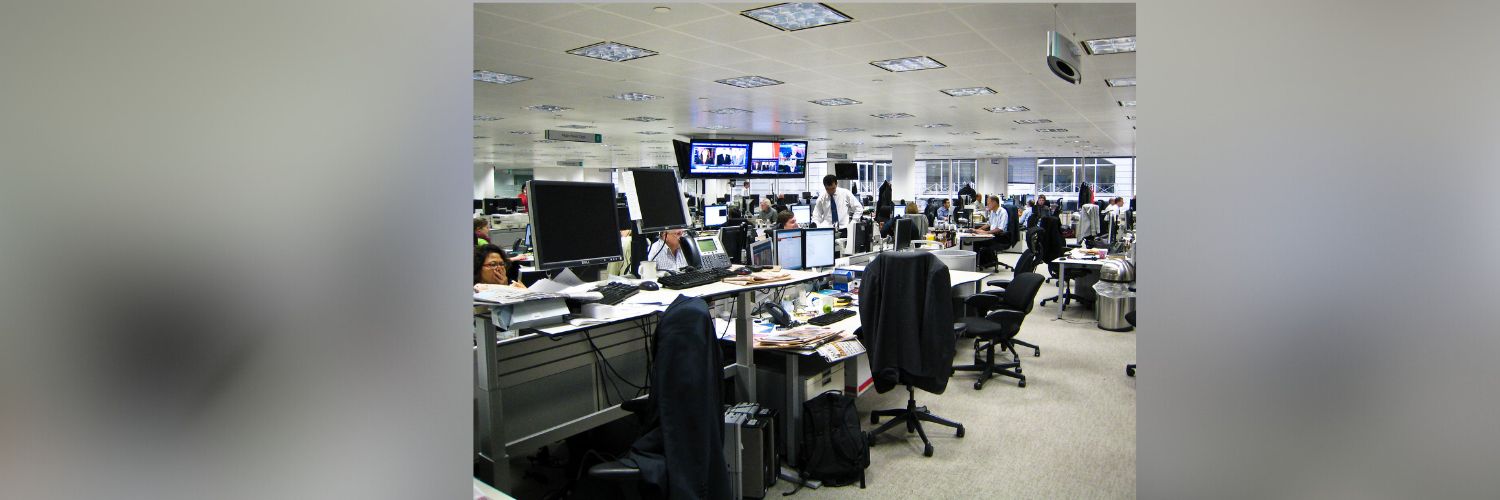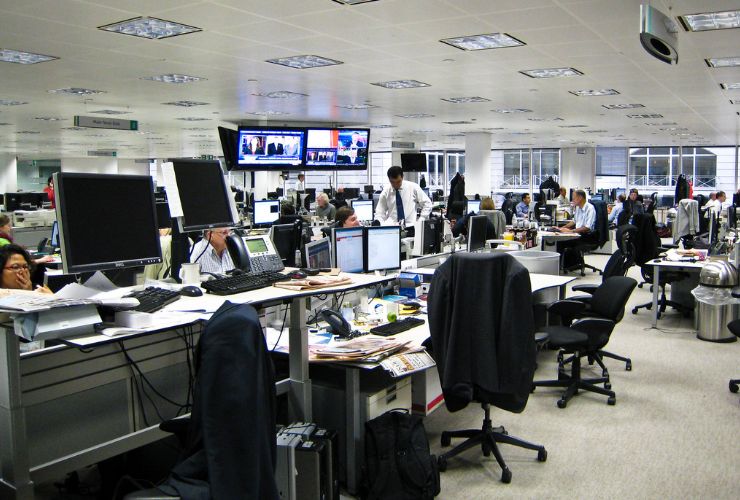

Newsroom Wrongs
The open secret in the media industry in India today is that many newsrooms are toxic. Abusive and unacceptable behaviour is passed down from media owners and editors to seniors to juniors to interns and freelancers. While we report on the dignity of labour in our stories, and promptly question any misbehaviour with journalists by anyone outside the media world, the story is very different on the inside.
Sexual harassment, gender-based discrimination and misogyny in a myriad forms have been identified as prominent features of many newsrooms across the country. This has prompted consistent interventions to try and improve the situation. Other forms of harassment have been less discussed and resisted: yelling, throwing insults around, aggressive and passive aggressive behaviour, shifting of work-related goalposts to create a constant sense of anxiety among staff, unhealthy levels of competition, unreasonable work hours and non-existent or dysfunctional grievance redressal mechanisms; these are all par for the course across too many newsrooms, whatever their size, shape or ideology. All too often such unacceptable conduct by leaders and/or peers, and such objectionable working conditions, are glossed over under the guise of journalism being ‘a greater calling’, ‘an important job’, ‘not a 9-to-5 role’, and other high-sounding claims of exceptionalism.
This needs to change.
With the weakening of the rights of journalists under the new Labour Codes, the erosion of the Wage Board system, and the resultant lack of job security, journalism has become increasingly precarious. Journalists today are under immense pressure from all sides, and the toxic atmosphere in media workplaces is endangering our health – both physical and mental. Many journalists – young and old – are leaving the industry mainly because of such unpleasant conditions of work. Some in the profession believe that the working conditions in certain newsrooms have led to the untimely deaths of some journalists. All this makes matters worse for media workers in a climate where journalists are already facing threats to their safety and lives from forces outside the media.
As media professionals we expect to be treated with respect and dignity by our colleagues and seniors. We expect our workplaces to demonstrate concern for our well-being by putting in place policies and processes that ensure that we have access to living wages, a safe and congenial work environment and a healthy work-life balance.
The Network of Women in Media, India, has put together this document in order to help build safe, civil and congenial newsrooms and workplaces in the media industry that uphold the values we associate with a profession widely recognised for the essential role it is meant to play as the Fourth Estate in a democracy.
Key Issues
At present there is widespread lack of respect in media organisations for individual employees and their rights as workers. Organisational attitudes towards fair policies and processes that protect labour rights leave much to be desired. The following are some of the existing problems in media workplaces that network members from across the country have flagged from personal experiences and first-hand observations.
- Humiliation and harassment
- Abusive behaviour such as shouting and screaming in the newsroom appears to be tolerated in many Indian media organisations. In most other industries, within India as well as elsewhere in the world, such behaviour would be considered unprofessional and unacceptable; in many organisations it would attract disciplinary action. Here editors and team leaders frequently shout at individuals – often in front of the rest of the team – using abusive and/or demeaning language or actions and sometimes even making personal attacks. This kind of public abuse is often accompanied by harassment in the form of text messages and emails on official messaging groups such as WhatsApp or comms and productivity apps such as Slack or Notion. Such behaviour is frequently justified with the claim that they – the seniors – ‘went through worse’.

Image by macrovector on freepik
- Disparaging and demeaning personal comments about bodies, lifestyles, clothes, marital status, relationships, parenthood, caste, economic status, education, gender, sexuality/sexual orientation, disability, and so on, that reflect prejudice and lack of respect are also commonly used to harass staff members, with women and LGBTQIA+ individuals facing the brunt of these attacks. Such insensitive, unethical and illegal behaviour has no place in any workplace. It is important to ensure that personal prejudices are not brought into newsrooms and used to harass and humiliate colleagues.
- Unfair newsroom practices
- Personal fiefdoms characterise many newsrooms, with hardly any transparency or accountability, and no strategies or institutional mechanisms for healthy conflict resolution. Such a situation enables unprofessional behaviour. This includes what can only be described as sabotage, such as the introduction of errors into a targeted journalist’s copy, changes in or removal of sentences/arguments from published (online) copy without prior discussion with the person whose byline is on the piece, stealing of story ideas, and so on.
- The ‘silent treatment’ is another method used to keep targeted journalists anxious and jittery, with superiors often ignoring mails/messages from them, including story pitches. Junior colleagues are also often ignored during team meetings, denied opportunities, and ‘pulled down a notch’ through sudden demotions in terms of work/shifts without any due process or explanation.
- ‘Gaslighting’ in the newsroom is also a pervasive problem, with editors and team leaders refusing to communicate properly with certain team members, discouraging transparency between team members, keeping no records of instructions and shifting goalposts after reporters/editors have already worked on a story. Such practices often lead to the journalists concerned questioning their own professional skills and understanding of subjects.
- Divisiveness is another common strategy used by editors and commissioning editors to create disparities in terms of who gets credit for stories on which more than one journalist has worked. Some commissioning editors are also known to reject ideas pitched by independent journalists and to then get their own staffers to work on the same stories. Bystander colleagues are discouraged from intervening during incidents of unacceptable behaviour in the workplace and anyone who does intervene is usually penalised. This makes it difficult for colleagues to build trust and maintain solidarity.
- Favouritism is also prevalent in many newsrooms, with journalists encouraged to apply for fellowships and awards or discouraged from doing so, based on their closeness to editors and team leaders. Journalists who are not in the good books of their bosses are often denied the required recommendation and approval letters for such applications. Similarly, bosses often refuse non-favourites permission for speaking engagements, often without a credible reason and sometimes in retaliation for speaking up.
- Physical separation of newsroom colleagues, with walls between teams and even individual journalists, makes it difficult for staffers to interact with each other, and share information about sources and resources, as well as about contracts, salaries and terms of employment. It also prevents them from exploring opportunities to pitch ideas for other sections/verticals within the same office. While it is understandable that an organisation needs dedicated personnel for specific roles, it is also true that flexibility and cooperation can often lead to better outcomes.
- Lack of clear policies on travel arrangements for reporters on outstation assignments. This creates problems, especially for women journalists. Expected to travel on shoestring budgets, reporters often have to settle for accommodation that is not hygienic and/or safe. In violation of legal provisions, some newsrooms also do not have adequate provisions to ensure safe commutes for female staff at night.
- Casteist, sexist, ableist, queerphobic behaviour
- Casteism continues to exist in many Indian newsrooms, as in the rest of society. Most media organisations have done little to address this important issue. Many journalists report being repeatedly asked for their surnames and/or being rejected for jobs after refusing to reveal their surnames (which would likely reveal their caste). They also report the frequent use of casteist slurs inside newsrooms in addition to derogatory remarks about the ‘merit’ of marginalised caste journalists. The few Adivasi and Dalit journalists who have made it into newsrooms across the country are often typecast and assigned beats that are confined to covering only their own communities.
- Sexism is also all too common. Some women report being denied jobs because they are mothers; others say job interviews include questions about pregnancy and plans for motherhood. Several women feel they are judged on the basis of their personal relationships and marital status unlike their male colleagues. Some mention that disparaging remarks about female journalists are common and adversely affect their morale. These include insinuations that they cannot cover ‘hard’ stories, mocking comments if they seek leave or flexi-hours during menstrual periods, questions about their plans for pregnancy, dismissal of legitimate child-care and elder care concerns, and so on.

Image by freepik
- Single women point out that they are often given extra responsibilities at work on the grounds that they should not mind the additional work burden or being asked to work extra hours and/or on holidays and weekends since they allegedly have no “family responsibilities”.
- LGBTQIA+ persons report that they are unable to be their authentic selves in most newsrooms because of the pervasive queerphobia and transphobia that go unchecked in media organisations.
- Sexual harassment in and around newsrooms is a reality that affects women and LGBTQIA+ persons in particular. Despite positive legislative and other developments over the past decade, many newsrooms still do not have institutional mechanisms in place to effectively address the problem.
- Persons with disabilities – visible or invisible, physical or psycho-social – feel unwelcome in newsrooms since most media organisations have no policies for reasonable accommodation in place. Journalists who disclose a disability often face disparaging remarks about the same either to their faces or behind their backs. Provisions to ensure accessibility for persons with disabilities – such as ramps, toilet facilities, flexible work hours, work from home policies, mental health leave, etc. – are evidently not a priority for most newsrooms.
- Poor working conditions and denial of rights
- Unspecified working hours – especially for reporters who are expected to be on duty all the time, including late at night and on off days. While it is true that some news stories involve sudden and rapid developments that sometimes require “all hands on deck”, this is not always the case and such a requirement is often overstated.
- No transparency and/or fairness in the approval of applications for leave. Personal equations and the whims of editors often override legal guarantees and organisational policies regarding leave.

Image by pch.vector on freepik
- Performance appraisal is often whimsical, and transparent processes are not followed for rating, promotion, pay hike and/or firing. Evaluation of performance is often subjective. Decisions on promotions and salary hikes often appear arbitrary. There is a tendency to look upon journalists demanding better pay as troublemakers and not as professionals seeking improvement in compensation for their work. The human resources (HR) departments of organisations need to ensure periodic and more open performance reviews by external reviewers to ensure transparency and fairness.
- Undefined scope of work and level of responsibility expected in different roles. Lack of clarity on the deliverables expected from journalists in various roles often leads to the setting of impractical and, worse, shifting targets. This sometimes results in reporters not being able to produce high quality stories.
- Safety training is absent in most organisations. Little is done to train journalists on safety measures to be taken while covering pandemics/epidemics, disasters, riots and violent conflicts, as well as other such situations that can affect the health and/or safety of reporters on the ground. Necessary equipment and accessories required for employees to stay safe in such situations are rarely provided.
- Non-compete clauses often included in contracts prevent journalists who leave one organisation from working for “rival” organisations for extended periods of time. In a situation where there is growing concentration of media ownership, with a large number of media organisations owned by four or five corporations, this often amounts to denial of alternative work opportunities.
- Absence of grievance redressal mechanisms for complaints regarding authoritarian, abusive or other forms of unacceptable behaviour in newsrooms makes the situation worse in many organisations. Too many newsrooms do not have HR professionals whose job it is to resolve conflicts between employees and/or between employees and bosses. Others have HR persons who are neither empowered nor willing to question the status quo in editorial departments, especially when work-related conflicts involve individuals in positions of power. Examples of situations that require institutional responses include lack of action against editors/leaders running newsrooms while inebriated, against gossip and slander intended to sabotage job opportunities, and against harassment and abuse. As a result, such behaviour continues over extended periods of time, vitiating the work environment.

Image by macrovector on freepik
- Unfair and illegal contracts that prohibit employees from joining unions and associations in the workplace are against the law but the practice continues. According to the law every worker has the right to join unions, the right of assembly, access to established systems for grievance redressal and collective bargaining.
In conclusion, the recognition and protection of journalists’ rights as human beings and as media workers are essential if they are to effectively play their part in promoting the democratic rights of fellow citizens, including the public’s right to information. The news media and journalism have traditionally been known as the Fourth Estate (the fourth pillar of democracy), creators of the first rough draft of history; they are expected to speak truth to power, print what someone somewhere wants hidden, and so on. This is no doubt the reason why, along with freedom of expression, media freedom is acknowledged as a necessary, indeed essential, part of democratic societies. What is less well recognised is that journalists are the foot soldiers who help and enable media organisations to fulfil these important duties.
Even as journalists continue to question and investigate conditions of labour in other industries, it is time for media houses to look within and improve the working conditions of their own staff. Media organisations and media employees need to work together to improve professional relationships in the workplace in order to create the congenial work environment required for them to uphold and fulfil the mandate of the press in democratic societies.
Guidelines for Safe Media Newsrooms
The Network of Women in Media, India believes that newsrooms need to be professionally and equitably run, with all employees treated with respect and fairness so that they enjoy safety and job security in their workplaces and are thereby enabled to perform at optimal levels. We believe the following conditions are necessary to ensure that media workplaces are as free and fair as their output is expected to be:
- Adherence to legally sanctioned hours of work. A working journalist can be expected to work for a maximum of 144 hours over four consecutive weeks with at least one day off every week, according to the Occupational Safety, Health and Working Conditions Code, 2020; working hours exceeding this limit need to be recognised as overtime.
- Provision of decent and regular salaries that reflect the professional nature of employment and are commensurate with the education, skills and experience required of journalists; salary structures that are benchmarked against remuneration for work requiring similar qualifications and talent in comparable industries and are also linked to cost of living and inflation levels; overtime as provided under the law; and job postings/advertisements that are transparent with regard to the financial compensation that can be expected.
- Provision of a minimum of 30 days of paid leave every year, including earned leave or Privilege Leave (PL), Casual Leave (CL), Sick Leave (SL), and Festival Leave (FL) as per the law, with mental health, menstruation and other health conditions to be covered under SL. Maternity, paternity and childcare leaves to be provided as per existing law. Transparent guidelines regarding when/why leave can be granted or denied must be available to all employees and team leaders; matters of leave to be handled by the HR team, not the editorial leadership. Extra days off for elder care and/or as reasonable accommodation of the special needs of persons with disabilities in leave policies would be welcome.
- Availability of independent, professional human resources management departments/teams that include leaders on par with leaders in editorial departments/teams; clear HR policies regarding what is and what is not acceptable behaviour in media workplaces.
- Provision of training for all employees and leaders on active bystander intervention against bullying/harassment in line with HR policies, along with policies to explicitly protect bystanders who intervene from retributive action from colleagues, team leaders, seniors and/or members of the management/governing board.
- Establishment of clear, transparent, nonarbitrary processes for internal performance appraisals; proper documentation of such processes; clearly defined Key Responsibility Areas (KRAs) and deliverables against which performance is measured so as to avoid arbitrary and/or inconsistent criteria for appraisals, promotions and/or pay raises; access to all staff of post-appraisal reports outlining the average percentage of salary hikes in different departments in the interest of organisational transparency.
- Provision for exit interviews that can provide departing employees with opportunities to explain their reasons for quitting. This will enable organisations to address problematic workplace issues that are flagged during the interviews.
- Establishment of grievance redressal mechanisms to address complaints of toxic behaviour in newsrooms, with provisions for confidentiality as well as neutral, objective fact-finding exercises if and when necessary; clear communication from the management about a zero tolerance approach to such behaviour and the fact that disciplinary action will be taken against anyone found flouting the rules, irrespective of position, power and popularity.
- Setting up of legally mandated Internal Committees to deal with sexual harassment, with representation from across departments as well as an impartial external member without personal or professional connections to the organisation or its management (as required by the law).
- Regular communication to new and existing employees regarding appropriate behaviour at work and about systems and mechanisms in place for voicing concerns about unwelcome workplace practices; periodic training on related policies and procedures for all employees, including senior leaders in the editorial department as well as in the management.
- Acknowledgement of the fact that inadequate staffing is an institutional problem and that vacancies must be filled as quickly as possible so that the burden of extra work is not shifted onto other employees for long periods; increased transparency about shortage of staff and circulation of information about existing vacancies.
- Sharing of anonymised diversity data about staff – including age, gender, caste, disability and sexuality – to increase transparency within the organisation.

Image by pch.vector on freepik
- Provision of safety training and safety kits to journalists on the ground; organisational support to reporters going into the field to cover dangerous situations, including wars, riots and other violent conflicts, as well as disasters – natural or human induced.
- Provision of paid-for legal aid to journalists – staffers or freelancers on assignment – facing legal cases or police action such as detention or arrest, until the matter is closed.
- Provision of necessary, paid-for healthcare for journalists – staffers or freelancers on assignment – who are injured in the course of their work; such healthcare must cover mental health problems diagnosed as arising from trauma encountered while covering disturbing events such as bomb blasts, violent conflicts, pandemics and disasters, as well as psychological distress caused by toxic behaviour in the workplace, such as sexual harassment or bullying.
- Recognition of freelancers/independent journalists as media professionals with an equal right to respectful, harassment-free work environments; availability in the public domain of organisational policies and procedures for freelance work, including information about contacts to which pitches can be sent, average expected timelines for decisions on pitches and between submission and publication, average remuneration for assignments, availability of allowances for commuting/travel expenses, provisions for kill fees, and so on.
- Provision of group health insurance coverage by industry bodies for freelancers/independent journalists with reasonable premium rates.
- Availability in the public domain of organisational policies concerning the employment of persons with disabilities and information about reasonable accommodations for the disabled, as per the law – including disabilities that are recognised globally but not under India’s Rights of Persons with Disabilities Act, 2016, such as some forms of neurodivergence, chronic pain, chronic fatigue syndrome and Long Covid, among others.
- Acceptance of the right of unions and/or associations dedicated to employees’ welfare to be allowed to operate in accordance with existing laws.
- Introduction of annual reports with anonymised data on interventions aimed at keeping the workplace safe and secure on various counts, as well as on cases reported and resolved.
The Network of Women in Media, India
15 August 2024
This document was compiled by Menaka Rao and Ragamalika Karthikeyan following an extensive discussion within the NWMI.
With inputs from:
Neethu Chandran,Rituparna Chatterjee,Shweta Desai, Haima Deshpande, Kajal Iyer, Jahanvi J, Ammu Joseph, Shahina KK, Neeta Kolhatkar, Laxmi Murthy, Annie Philip, Prachi Pinglay, Navya PK, Asha Prakash, Nithya Prakash, Arshie Qureshi, Geeta Seshu, Prachi Sibal, Lalitha Suhasini, Anumeha Yadav.
Click here to download this document.



